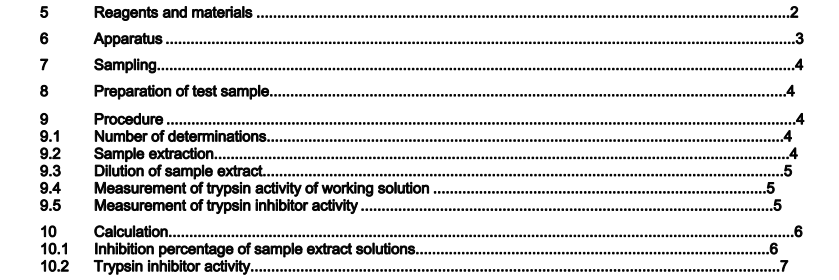BS EN ISO 14902:2001 – Animal feeding stuffs — Determination of trypsin inhibitor activity of soya products

1 Scope This International Standard specifies a method for the determination of the trypsin inhibitor activity (TIA) of soya products. This trypsin inhibitor activity is indicative of the degree of toasting of these products.
The detection limit of the method is 0,5 mg/g. 2 Normative reference The following normative document contains provisions which, through reference in this text, constitute provisions of this International Standard. For dated references, subsequent amendments to, or revisions of, any of these publications do not apply. However, parties to agreements based on this International Standard are encouraged to investigate the possibility of applying the most recent edition of the normative document indicated below.
For undated references, the latest edition of the normative document referred to applies. Members of ISO and IEC maintain registers of currently valid International Standards.
ISO 3696:1987, Water for analytical laboratory use — Specification and test methods
3 Term and definition For the purposes of this International Standard, the following term and definition applies.
3.1 trypsin inhibitor activity TIA mass of trypsin inhibited by the procedure described in this International Standard, divided by the mass of the test sample NOTE The trypsin inhibitor activity is expressed in milligrams per gram.
4 Principle Trypsin inhibitors are extracted from the sample at pH 9,5. The remaining trypsin activity is measured by adding benzoyl- L -arginine- p -nitroanilide (L-BAPA) as substrate. The quantity of released p -nitroaniline is measured spectrometrically.
5 Reagents and materials
Use only reagents of recognized analytical grade.
5.1 Water, complying with at least grade 3 in accordance with ISO 3696.
5.2 Sodium hydroxide solution, c (NaOH) = 0,01 mol/l.
5.3 Hydrochloric acid, c (HCl) = 6 mol/l.
5.4 Hydrochloric acid, c (HCl) = 1 mol/l.
5.5 Hydrochloric acid, c (HCl) = 0,1 mol/l.
5.6 Hydrochloric acid, c (HCl) = 0,001 mol/l.
5.7 Acetic acid, c (CH 3 COOH) = 5,3 mol/l.
5.8 Calcium chloride dihydrate, CaCl 2 ×2H 2 O.
5.9 Calcium chloride solution in hydrochloric acid.
Dissolve 735 mg of calcium chloride dihydrate (5.8) in 1 l of hydrochloric acid (5.6) and check the pH. The pH shall be 3,0 ± 0,1.
5.10 Bovine trypsin (Merck No. 24579 or equivalent). 1)
See 9.4 for measurement of the activity. Store in the refrigerator (6.3).
5.11 Trypsin stock solution
Allow the trypsin (5.10) to reach room temperature. Dissolve 27,0 mg of trypsin in the calcium chloride solution (5.9) in a 100 ml volumetric flask (6.1) and dilute to the mark with the calcium chloride solution. This solution can be used for 5 days at most when stored in the refrigerator (6.3).
5.12 Trypsin working solution.
Pipette 5 ml of the trypsin stock solution (5.11) into a 100 ml volumetric flask (6.1) and dilute to the mark with calcium chloride solution (5.9).
5.13 Benzoyl- L -arginine- p -nitroanilide (L-BAPA).
5.14 Tris-(hydroxymethyl)aminomethane (Tris).
5.15 Dimethyl sulfoxide (DMSO).
5.16 Tris buffer/calcium chloride solution.
Dissolve 6,05 g of Tris (5.14) and 735 mg of calcium chloride (5.8) in 900 ml of water in a 1 l graduated measuring cylinder. Adjust the pH to 8,2 ± 0,1 with hydrochloric acid (5.3) and dilute to 1 l with water.
5.17 L-BAPA reagent.
Prepare this reagent on the day of use. Dissolve 60 mg of L-BAPA (5.13) in 1 ml of DMSO (5.15) in a 100 ml volumetric flask (6.1) and dilute to the mark with Tris buffer/calcium chloride solution (5.16).
BS EN ISO 14902:2001 – Animal feeding stuffs — Determination of trypsin inhibitor activity of soya products